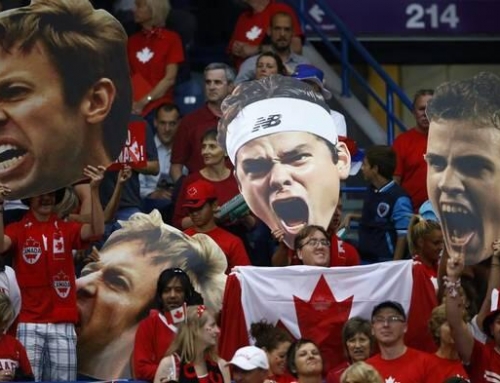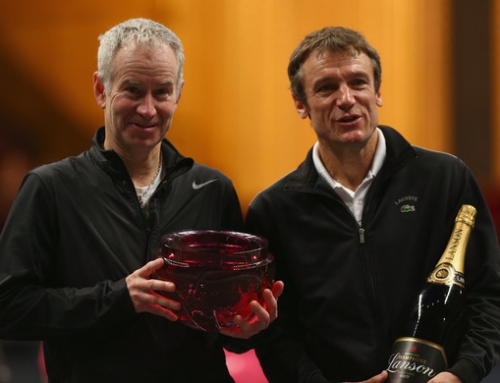Davis Cup is the closest that tennis has to a team challenge outside of the Olympics. Because we’re so obsessed with the best players playing Davis Cup, we fret that Roger Federer, Andy Roddick, and Andy Murray have frequently begged out of Davis Cup duties to focus on the Slams. It’s interesting how many people have spent so much effort trying to change things up, from having a “World Cup of Tennis” played only once in four years, to a single site tournament a la the Hopman Cup. Imagine trying to tinker with other sports. How many people would like futbol (as I’ll call soccer) to play the World Cup once every two years, or perhaps every year?
But let’s not digress too far. Let’s talk about the next round of Davis Cup. This past week, the first round of Davis Cup was played and the US was eliminated, yet again, by a team playing on indoor clay. Last time it was Croatia, this year, Serbia.
Perhaps it’s fitting that in the next round, Croatia will face Serbia. This will be interesting. Croatia certainly has reasons to dislike Serbia due to a military conflict in the early 1990s (or vice versa). Emotions may be at a fever pitch. The site for the tie has yet to be determined since this is the first time both have met. Key to the tie is Marin Cilic, who has recently joined the top 10, and Novak Djokovic, currently ranked 2. The two had a tough match in the US Open back in 2008. Arguably, Ivo Karlovic, at number 2, is a big wildcard.
Should Croatia host, they may want to play on a fast surface to best help Karlovic. Cilic is proficient on the hard courts, so he could play on a pretty fast surface. Serbia would have an advantage in doubles. For this reason, if Serbia hosts, they will probably pick clay too.
Spain vs. France will be a top-heavy tie. Both countries boast numerous players in the top 50 and could run two entire teams that would be competitive with any team in the world group. When teams like Switzerland (minus Federer) or Sweden struggle to find a player that can play a solid number 2, both countries have a multitude of good players including the world number 3, Rafael Nadal.
France will host this tie. They played Gael Monfils and Jo-Wilfried Tsonga. Since Spain is so good on clay, they are likely to play on a faster surface. Nadal’s weakest surface is hard courts, but this is only by comparison. Nadal has twice reached the semis of the US Open, which isn’t too shabby for almost anyone else. A faster surface would mean players like Ferrer and Ferrero might be at more of a disadvantage. However, Verdasco plays well on faster surfaces. Even Lopez isn’t too shabby on fast surfaces. This will be one talented tie.
Russia plays Argentina. Normally, Argentina should have made it to this round with no problems. They struggled against Sweden who lacks a credible number 2 after Robin Soderling. It took a recovering David Nalbandian, once ranked as high as 2, to win a critical fifth rubber. Both Juan Martin del Potro and Juan Monaco were injured, requiring Nalbandian to play a singles he didn’t expect to play. Youzhny and Kunitsyn played for Russia. This could be a tight match. Russia hosts and is likely to play on a faster surface. They have to hope either del Potro doesn’t play or that they can take the other 3 matches. Each country has one “strong” player. Mikhail Youzhny for Russia and Juan Martin del Potro for Argentina. On paper, Argentina will have the stronger team, because their number 2 is either Monaco or Nalbandian, depending how Nalbandian is doing in a few months.
The next tie will be between the winner of Chile and Israel and the Czech Republic. Due to the earthquake, the tie between Chile and Israel has not concluded. The Czech Republic has perhaps a better 1-2 punch in Radek Stepanek and Tomas Berdych, which should prove formidable for whoever they play. Chile has Fernando Gonzalez, but they only have an OK second player.
The US was a bit unlucky this year as there were several countries they could have been competitive against. They would have had a decent advantage over India, Belgium, and perhaps Russia, Israel, Chile, Sweden, Switzerland. They would have had problems with Spain, Croatia, Serbia, and France.




![[Davis Cup, QF, Day 3] Raonic wins over Seppi, clinches tie to move to semis](https://www.essentialtennis.com/wp-content/uploads/2013/04/20130407milos-500x383.jpg)
![[Davis Cup QF, Day 2] North American teams go the distance in doubles](https://www.essentialtennis.com/wp-content/uploads/2013/04/20130406serb-500x383.jpeg)
![[Davis Cup, 1R] Sam Querrey wins fifth rubber to advance US past Brazil](https://www.essentialtennis.com/wp-content/uploads/2013/02/20130203sam-500x383.jpg)
